Wall Back to Building Baits
Pro Circuit angler rekindles passion for making lures this offseason
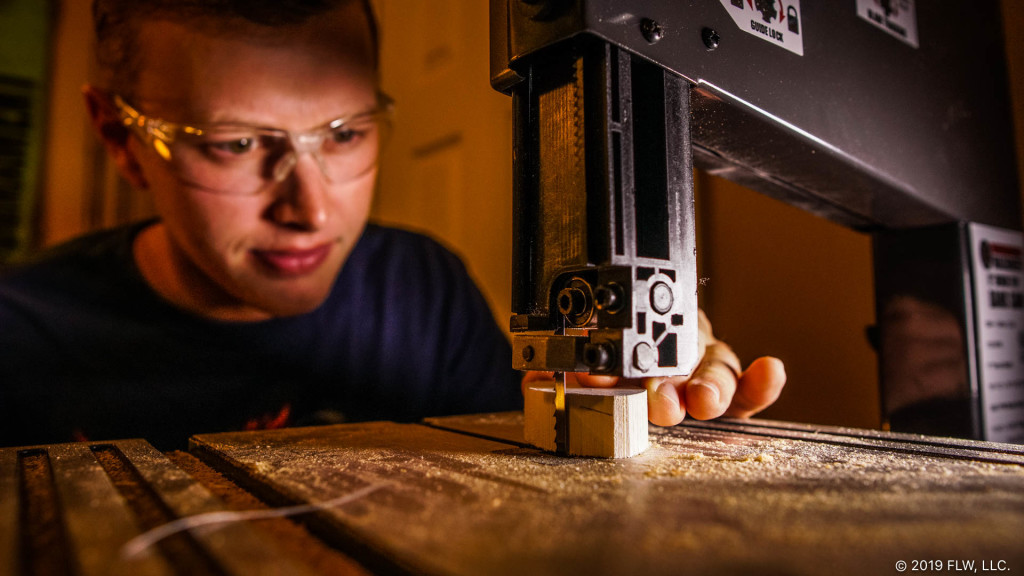
The offseason for many professional anglers is a time to hang out with family and take a step away from a bass boat, while some even swap time on the water for time in a deer stand or duck blind. Not so for Jacob Wall, who just wrapped his first year as a professional angler.
Wall is a fish-head. If he’s not on the water, he’s probably working on tackle or searching for ponds to hop around the house.
Though Wall has spent the majority of his downtime this fall preparing for the 2020 FLW Pro Circuit, it also has allowed him to reunite with an old passion of his: building wooden swimbaits.
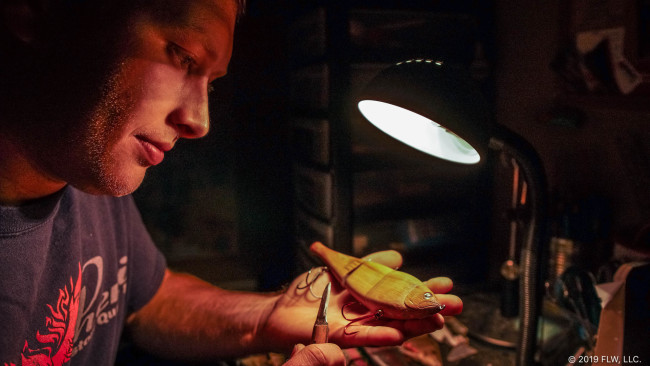
Lighting the fire
Understanding where Wall’s passion for building swimbaits comes from takes a quick glance at where he grew up. Though he now resides in New Hope, Ala., Wall actually grew up in Jacksonville, Ore., which isn’t necessarily in the heart of bass country – though it is well within the radar of the West Coast swimbait movement.
“I got really fascinated by it because I lived in an area with a lot of trout, and guys were crushing big bass with swimbaits and glide baits in California on lakes just like where I fished,” Wall says. “The more swimbait fishing became popular, the more my buddy Colby Pearson and I got into it.”
Wall figures he was about 15 years old when he really got into trying to make baits with Pearson, spending their time after class during the week and on weekends trying to recreate the glide baits that were producing monster bass in California.
“When you’re 17 trying to buy some of those glide baits, you’d be breaking bank to do it, and they’re still expensive,” explains Wall. “But that’s how Colby and I got interested in building them, because we wanted to fish those baits, but couldn’t afford them. We started cutting up some wood and made our first few three-piece jointed baits. They were a simple screw eye-to-screw connection. It’s a good connection, but it doesn’t look clean, but they caught fish. We used to fish them in a pond, and I don’t know how many fish we caught on them – probably 30 to 40 fish. And they weren’t little baits either. I’d say the first few were anywhere from 7 to 12 inches.”
Armed with some simple hand tools, Pearson and Wall created several swimbaits throughout high school. Wall admits Pearson was better at detailed carving, while Wall was better with painting – so they made a solid duo. It wasn’t until Wall received an airbrushing tool for Christmas that the duo could really start creating well-rounded swimbaits.
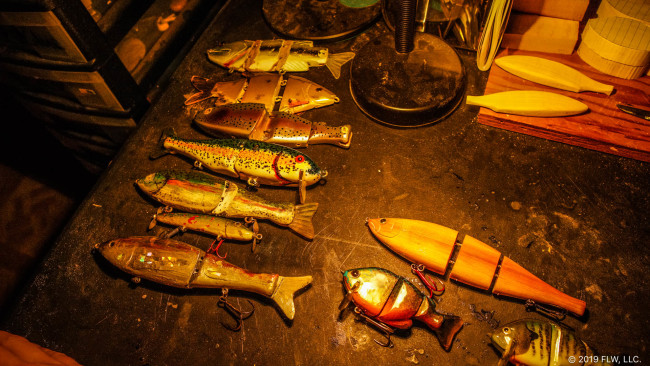
“The baby bass (pictured top left) was the first bait I airbrushed. The golden shiner (second from top left) was the first where I got more realism out of the airbrush. It’s hard to make them look really good, and I was really proud of how that golden shiner looked.”
Wall lost touch with building baits once he started college at the University of Oregon, but his degree allowed him to dabble in it from time to time.
“I got a degree in Product Design and Fine Art, so I was in wood shop quite a bit in college,” he says. “When I wasn’t working on a project, I’d spend time in the wood shop cutting pieces for baits, but I never got around to finishing them. I didn’t have to space or tools I needed at college to finish them, but it was always in the back of my mind. I’d have pieces of wood that I’d draw shapes on, get them smoothed out, sanded, but I didn’t joint or paint them.”
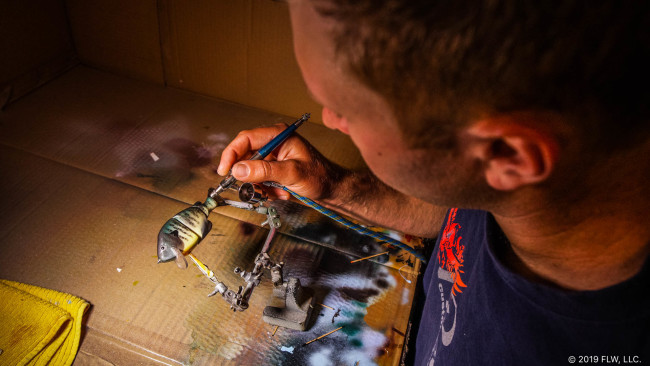
Enjoying the process
Moving from Oregon to Alabama and fishing this past season on the FLW Tour put another damper on making time to craft baits. Now, this offseason has given him time to reconnect with one of his favorite pastimes.
“Having the right tools makes all the difference,” adds Wall. “Until now, everything I made was hand-sawed and then I used hand tools to get the general shape. A drill and Dremel were the only two power tools I’d use. But, the other week I bought a band saw and it has made it much easier to make baits. It probably took me seven to nine hours with hand tools to make a bait before, but now it’s more like four to six. It’s a lengthy process to build baits, but when you see them at the end, it looks way cool.”
Other than the obvious money-saving aspect of making your own glide baits or wake baits, Wall appreciates nearly every aspect of creating something with which to fool a bass. It gives him a chance to express his passion for fishing, even when he’s not on the water.
“I have a couple favorite parts of the building process,” he admits. “Getting the wood smoothed and shaped to how you want is cool. Going from a 60-grit to 220-grit sandpaper and getting the wood buttery smooth is a really promising stage. Another thing I like, and I don’t do it to every bait, is carving scales into the sides of the bait. I’ve started doing it recently for myself or personal collection I have, but the detailed carving is really satisfying. Really, the whole process is fun. Turning a block of wood into a fish shape and then a functional fish shape that does what you want it to do is so cool.
“And then once you catch a fish on something you’ve made is awesome. Such a cool feeling.”
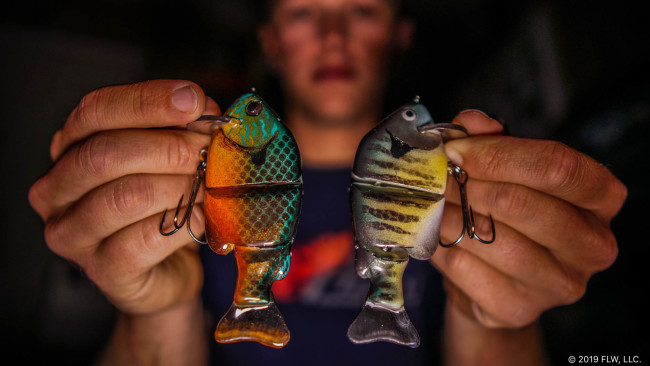
Passion into profit
Having followed the swimbait movement for some time, Wall is well aware of the demand for high-quality swimbaits. That’s probably why he’s been toying with the idea of selling a few of his creations.
“I’m leaning the direction of doing this as a part-time business,” says the 25-year-old pro. “I’ve been immersed in the swimbait game for a while now as well as being part swimbait fanatic, and it’s something that intrigues me when I’m not tournament fishing. I’ve always wanted to do something that keeps me involved in my passion. And hey, if I can make a little money off it on the side, that’s even better. There are quite a few people interested in what I’m doing, and I’ve gotten some good feedback on my Instagram. What was holding me back was not making them that fast, but it pushed me to get more tools and get to more of a production level.
“It’s been something I’m really trying to step my game up at. I’ve made probably 40 to 50 baits since I started doing it. I’ve made seven since I started doing it again about three weeks ago – and that’s with trying to fish and finish sponsor stuff. Now I’ll have a little more time and I’m excited to see where it goes.”